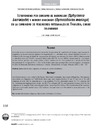Please use this identifier to cite or link to this item:
https://accedacris.ulpgc.es/jspui/handle/10553/77203
| DC Field | Value | Language |
|---|---|---|
| dc.contributor.author | Gaitán Espitia, Juan Diego | en_US |
| dc.date.accessioned | 2021-01-15T17:10:53Z | - |
| dc.date.available | 2021-01-15T17:10:53Z | - |
| dc.date.issued | 2007 | en_US |
| dc.identifier.issn | 1794-5992 | en_US |
| dc.identifier.other | WoS | - |
| dc.identifier.uri | https://accedacris.ulpgc.es/handle/10553/77203 | - |
| dc.description.abstract | An icthyotoxism event was studied in the Tasajera fishermen's community, department of Magdalena. The ciguatera intoxication was diagnosed to 7 individuals whose ages were ranging between 17 and 53 years (63,4 %), with symptoms of vomit (100 %), muscular pain in low members (71,4 %), abdominal spasms (85,7 %), diarrhea (100 %), numbness and tingling of face, hands, feet (85,7 %), sickness (100 %), and cutaneous outbreak (14,2 %), the symptoms in the majority of the cases disappeared in a space from 8 to 12 days. The consumption of the barracuda (Sphyraena barracuda) spotted moray (Gymnothorax moringa) meat was determined as principal source of the ciguatera event. | en_US |
| dc.description.abstract | Se estudió un evento de ictiotoxismo en la comunidad de pescadores de la población de Tasajera, departamento del Magdalena. La intoxicación por ciguatera fue diagnosticada a 7 individuos cuyas edades oscilaban entre los 17 y 53 años (63,4% de rango de edades de los pescadores del sector), con síntomas de vómito (100%), dolor muscular en miembros inferiores (71,4%), espasmos abdominales (85,7%), diarrea (100%), entumecimiento y hormigueo de cara, manos, pies (85,7%), mareo (100%), y brote cutáneo (14,2%), los síntomas en la mayoría de los casos desaparecieron en un lapso de 8 a 12 días. Se determinó como causa principal del evento de ciguatera el consumo de carne de barracuda (Sphyraena barracuda) y morena (Gymnothorax moringa). | en_US |
| dc.language | spa | en_US |
| dc.relation.ispartof | Duazary | en_US |
| dc.source | Duazary [ISSN 1794-5992], v. 4 (2), p. 160-167, (Julio-Diciembre 2007) | en_US |
| dc.subject | 310907 Patología | en_US |
| dc.subject.other | Icthyotoxism | en_US |
| dc.subject.other | Ciguatera | en_US |
| dc.subject.other | Intoxication | en_US |
| dc.subject.other | Colombian Caribbean | en_US |
| dc.subject.other | Ictiotoxismo | en_US |
| dc.title | Ictiotoxismo por consumo de barracuda (Sphyraena barracuda) y morena manchada (Gymnothorax moringa) en la comunidad de pescadores artesanales de Tasajera, caribe colombiano | en_US |
| dc.title.alternative | Ictiotoxismo Consumption by Barracuda (Sphyraena barracuda) and Spotted Moray (Gymnothorax moringa) in the fishing community of artisan Tasajera colombian caribbean | en_US |
| dc.type | info:eu-repo/semantics/Article | en_US |
| dc.type | Article | en_US |
| dc.identifier.isi | 000210111000010 | - |
| dc.identifier.eissn | 2389-783X | - |
| dc.description.lastpage | 167 | en_US |
| dc.identifier.issue | 2 | - |
| dc.description.firstpage | 160 | en_US |
| dc.relation.volume | 4 | en_US |
| dc.investigacion | Ciencias de la Salud | en_US |
| dc.type2 | Artículo | en_US |
| dc.contributor.daisngid | 25765474 | - |
| dc.description.numberofpages | 8 | en_US |
| dc.utils.revision | Sí | en_US |
| dc.contributor.wosstandard | WOS:Espitia, JDG | - |
| dc.date.coverdate | Julio-Diciembre 2007 | en_US |
| dc.identifier.ulpgc | Sí | en_US |
| dc.description.esci | ESCI | |
| dc.description.erihplus | ERIH PLUS | |
| item.grantfulltext | open | - |
| item.fulltext | Con texto completo | - |
| Appears in Collections: | Artículos | |
WEB OF SCIENCETM
Citations
1
checked on Feb 25, 2024
Page view(s)
108
checked on Aug 10, 2024
Download(s)
57
checked on Aug 10, 2024
Google ScholarTM
Check
Share
Export metadata
Items in accedaCRIS are protected by copyright, with all rights reserved, unless otherwise indicated.
